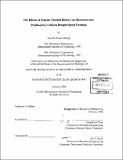The effects of deposit thermal history on microstructure produced by uniform droplet spray forming
Author(s)
Cherng, Jean-Pei Jeanie
DownloadFull printable version (9.471Mb)
Other Contributors
Massachusetts Institute of Technology. Dept. of Mechanical Engineering.
Advisor
Jung-Hoon Chun.
Terms of use
Metadata
Show full item recordAbstract
Uniform droplet spray forming is a process aimed at producing near-net-shape parts directly from the liquid melt by spraying micron-sized droplets onto a movable target. In spray forming, the solidification rate of the deposited material is a key parameter that influences its microstructure formation and consequently, its mechanical properties. Ideal deposit microstructure has fine grain size and minimal segregation. The purpose of this thesis is to quantify the effects of deposit thermal history on the microstructure produced by the UDS forming process. Experiments were conducted with Zn-20wt% Sn alloy droplets using different process parameters to vary the deposit solidification rate from 6⁰C/s to 27⁰C/s immediately after deposition. The temperature of the sprayed deposits was measured in situ with a fiber-optic infrared thermometer and a contact thermocouple. Furthermore, a 2-D axisymmetric finite element model was developed to predict the temperature of the deposit during and after deposition. The simulation results show that radial heat conduction cannot be neglected when the thermal diffusivity of the substrate material is comparable to the diffusivity of the deposit material. Simulation results showed good agreement with the measured temperature data. The resultant deposit microstructures were examined with scanning electron microscopy, which revealed that the deposit microstructure includes a mixture of solidified phases formed inside the droplets before impact. (cont.) The characteristic cell size of the microstructure was shown to vary inversely with the square root of the deposit solidification rate. This implies that the growth of the microstructure is interface- controlled rather than diffusion-controlled, due to the high volume fraction of solid during deposition. Furthermore, the homogeneity of the deposit microstructure across its thickness suggests that the rapid solidification rate of the individual droplet layers upon impact played a minor role in determining the final deposit microstructure. In conclusion, this research has developed a new methodology for studying the evolution of deposit microstructure in uniform droplet spray forming. The processing regime that promotes the layer-wise growth of deposits without porosity or liquid overflow has produced fine-scale deposit microstructure. The coarsening kinetics of the microstructure are interface-controlled by the deposit solidification rate. A uniform local solidification rate after deposition resulted in homogeneous deposit microstructure.
Description
Thesis (Ph. D.)--Massachusetts Institute of Technology, Dept. of Mechanical Engineering, 2002. Includes bibliographical references (leaves 87-90).
Date issued
2002Department
Massachusetts Institute of Technology. Department of Mechanical EngineeringPublisher
Massachusetts Institute of Technology
Keywords
Mechanical Engineering.
